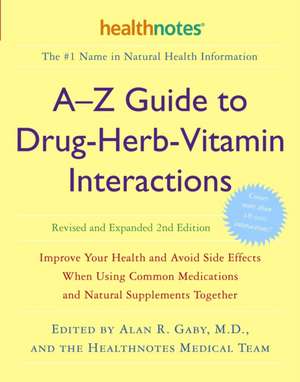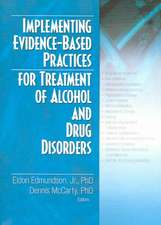A-Z Guide to Drug-Herb-Vitamin Interactions: Improve Your Health and Avoid Side Effects When Using Common Medications and Natural Supplements Together
Editat de Alan R. Gaby, Forrest Batz, Rick Chesteren Limba Engleză Paperback – 31 ian 2006
If you’re among the millions of people taking prescription and over-the-counter drugs, as well as vitamins and natural medicines, you need to know which combinations are potentially helpful and which can be extremely dangerous. The A–Z Guide to Drug-Herb-Vitamin Interactions is an essential resource to understanding the interactions that may affect your health.
From the experts at Healthnotes, this revised and updated edition contains the newest information on thousands of drugs and supplements, based on studies published in the leading medical journals. Reliable and easy to use, this book is sure to become a trusted reference in your home.
MORE THAN 18,000 DRUG-HERB-VITAMIN INTERACTIONS
Find out about:
• Drugs that can deplete your body’s nutrients
• Supplements that can interfere with drug absorption
• Side effects of common drug-herb-vitamin combinations
• Supplements that can help your prescriptions work better
• Combinations that should never be taken together
• With a foreword by Dr. Bob Arnot
Preț: 147.51 lei
Preț vechi: 155.27 lei
-5% Nou
Puncte Express: 221
Preț estimativ în valută:
28.23€ • 29.36$ • 23.31£
28.23€ • 29.36$ • 23.31£
Carte disponibilă
Livrare economică 24 martie-07 aprilie
Preluare comenzi: 021 569.72.76
Specificații
ISBN-13: 9780307336644
ISBN-10: 0307336646
Pagini: 338
Dimensiuni: 216 x 273 x 19 mm
Greutate: 0.81 kg
Ediția:Revised and Upd
Editura: Three Rivers Press (CA)
ISBN-10: 0307336646
Pagini: 338
Dimensiuni: 216 x 273 x 19 mm
Greutate: 0.81 kg
Ediția:Revised and Upd
Editura: Three Rivers Press (CA)
Extras
Part 1
Interactions by Drug
Some interactions may increase the need for the herb, other interactions may be negative and indicate the herb should not be taken without first speaking with your physician or pharmacist. Others may require further explanation. An asterisk (*) next to an item in the summary indicates that the interaction is supported only by weak, fragmentary, and/or contradictory scientific evidence. Refer to the individual drug entry for specific details about an interaction. The following list only includes the generic or class name of a medicine—to find a specific brand name, use the index.
Accuretic
Contains the following ingredients:
Hydrochlorothiazide (page 000)
Quinapril (page 000)
Acebutolol
Common names: Sectral
Combination drug: Secradex
Acebutolol is used to treat high blood pressure and certain forms of heart arrhythmia, and is in a family of drugs known as beta-adrenergic blockers (page 000).
Summary of Interactions for Acebutolol
In some cases, an herb or supplement may appear in more than one category, which may seem contradictory. For clarification, read the full article for details about the summarized interactions.
Avoid: Reduced drug absorption bioavailabilityFood
Avoid: Adverse interactionHigh-potassium foods*
Pleurisy root*
Potassium supplements*
Depletion or interferenceNone known
Side effect reduction/preventionNone known
Supportive interactionNone known
Interactions with Dietary Supplements
Potassium
Some beta-adrenergic blockers (called “nonselective” beta blockers) decrease the uptake of potassium from the blood into the cells, leading to excess potassium in the blood, a potentially dangerous condition known as hyperkalemia. People taking beta-blockers should therefore avoid taking potassium supplements, or eating large quantities of fruit (e.g., bananas), unless directed to do so by their doctor.
Interactions with Herbs
Pleurisy root
As pleurisy root and other plants in the Aesclepius genus contain cardiac glycosides, it is best to avoid use of pleurisy root with heart medications such as beta-blockers.
Interaction with Foods and Other Compounds
Taking acebutolol with food slows the rate of absorption and reduces the maximum blood levels of the drug, though overall absorption is not affected. However, the blood level of an active breakdown product of acebutolol is reduced. Though the activity of acebutolol is affected by food, people taking the drug on a daily basis are not likely to experience a reduction in the effectiveness of the drug if it is taken with a meal.
Acetaminophen
Common names: 222 AF, Abenol, Acetab, Acet, Alisphene Forte, Alvedon, Anadin Paracetamol, APAP, Apo-Acetaminophen, Artritol, Atasol, Boots Children’s Pain Relief Syrup, Boots Cold Relief Hot Blackcurrant, Boots Cold Relief Hot Lemon, Boots Infant Pain Relief, Calpol 6 Plus, Calpol Infant, Calpol Pediatric, Calpol, Cephanol, Children’s Acetaminophen, Children’s Feverhalt, Cupanol Over 6, Cupanol Under 6, Disprol, Dom-Acetaminophen, Fanalgic, Fennings Children’s Cooling Powders, Hill’s Balsam Flu Strength Hot Lemon Powders, Infadrops, Lem-Plus Powders, Medinol, Novogesic, Pain Aid Free, Paldesic, Panaleve 6+, Panaleve Junior, Pandol, Panodol Baby and Infant, Paracetamol, Paracets, Paraclear, Paramin, Pediatrix, PMS Acetaminophen, Resolve, Robigesic Elixir, Rounox, Salzone, Tantaphen, Tempra, Tixymol, Tramil 500, Trianon, Tylenol, WestCan Extra Strength Acetaminophen, WestCan Regular Strength Acetaminophen
Combination drugs: Alka-Seltzer Plus, Co-Proxamol, Coalgesic, Darvocet N, Distalgesic, Endocet, Excedrin PM, Fioricet, Lortab, Midrin, Nyquil, Nyquil Hot Therapy Powder, Percocet, Phrenilin, Propacet 100, Roxicet, Theraflu, Tylenol Allergy Sinus, Tylenol Cold, Tylenol Flu NightTime Maximum Strength Powder, Tylenol Multi-Symptom Hot Medication, Tylenol PM, Tylenol Sinus, Tylenol with Codeine, Vicodin, Wygesic
Acetaminophen is used to reduce pain and fever.
Unlike NSAIDs (nonsteroidal anti-inflammatory drugs) (page 000), it lacks anti-inflammatory activity. Acetaminophen is available by itself or in nonprescription and prescription-only combination products used to relieve pain and the symptoms associated with colds and flu.
Summary of Interactions for Acetaminophen
In some cases, an herb or supplement may appear in more than one category, which may seem contradictory. For clarification, read the full article for details about the summarized interactions.
May be Beneficial: Side effect reduction/preventionMilk thistle*
N-acetyl cysteine
May be Beneficial: Supportive interactionVitamin C*
Avoid: Reduced drug absorption/bioavailabilityHibiscus
Check: OtherSchisandra
Depletion or interferenceNone known
Adverse interactionNone known
Interactions with Dietary Supplements
N-acetyl cysteine (NAC)
Hospitals use oral and intravenous N-acetyl cysteine (NAC) to treat liver damage induced by acetaminophen overdose poisoning. NAC is often administered intravenously by emergency room doctors. Oral NAC appears to be effective for acetaminophen toxicity.
An uncontrolled trial compared intravenous NAC with oral NAC in children with acetaminophen poisoning and found that both methods were equally effective in reversing acetaminophen-induced liver toxicity. However, acetaminophen toxicity is a potential medical emergency, and should only be managed by qualified healthcare professionals.
Vitamin C
Taking 3 grams vitamin C with acetaminophen has been shown to prolong the amount of time acetaminophen stays in the body. This theoretically might allow people to use less acetaminophen, thereby reducing the risk of side effects. Consult with a doctor about this potential before reducing the amount of acetaminophen.
Interactions with Herbs
Hibiscus
One small study found that hibiscus could decrease levels of acetaminophen if the drug was taken after the tea was consumed though it was not entirely clear if the decreases were clinically significant.
Milk thistle (Silybum marianum)
Silymarin is a collection of complex flavonoids found in milk thistle that has been shown to elevate liver glutathione levels in rats. Acetaminophen can cause liver damage, which is believed to involve glutathione depletion. In one study involving rats, silymarin protected against acetaminophen-induced glutathione depletion. While studies to confirm this action in humans have not been conducted, some doctors recommend silymarin supplementation with 200 mg milk thistle extract, containing 70–80% silymarin, three times per day for people taking acetaminophen in large amounts for more than one year and/or with other risk factors for liver problems.
Schisandra (Schisandra chinensis)
Gomisin A is a constituent found in the Chinese herb schisandra. In a study of rats given liver-damaging amounts of acetaminophen, gomisin A appeared to protect against some liver damage but did not prevent glutathione depletion (unlike milk thistle, as reported above). Studies have not yet confirmed this action in humans.
Interactions with Foods and Other Compounds
Food
Food, especially foods high in pectin (including jellies), carbohydrates, and large amounts of cruciferous vegetables (broccoli, Brussels sprouts, cabbage, and others) can interfere with acetaminophen absorption. It is unclear how much effect this interaction has on acetaminophen activity.
Alcohol
Moderate to high amounts of acetaminophen have caused liver damage in people with alcoholism.10 To prevent problems, people taking acetaminophen should avoid alcohol.
Acezide
Contains the following ingredients:
Captopril (page 000)
Hydrochlorothiazide (page 000)
Actonorm Gel
Contains the following ingredients:
Aluminium
Dimethicone
Magnesium
Peppermint oil
Acyclovir Oral
Common names: Virovir, Zovirax Oral
Acyclovir is an antiviral drug used to treat shingles, genital herpes, and chickenpox.
Summary of Interactions for Acyclovir Oral
In some cases, an herb or supplement may appear in more than one category, which may seem contradictory. For clarification, read the full article for details about the summarized interactions.
May be Beneficial: Supportive interactionCitrus root bark*
Flavonoids*
Geum japonicum*
Rhus javanica*
Syzygium aromaticum*
Terminalia chebula*
Tripterygium wilfordii*
Depletion or interferenceNone known
Side effect reduction/preventionNone known
Reduced drug absorption/bioavailabilityNone known
Adverse interactionNone known
Interactions with Dietary Supplements
Flavonoids
The flavonoids quercetin, quercitrin, and apigenin enhanced the antiviral activity of acyclovir in test tube studies. Controlled research is needed to determine whether taking quercetin or other flavonoid supplements would increase the effectiveness of acyclovir in humans.
Interactions with Herbs
Citrus species
The alkaloid citrusinine-1 from the root bark of citrus plants has been shown to enhance the antiviral activity of acyclovir. Further research is needed to determine whether taking citrus root bark would increase the effectiveness of acyclovir in humans.
Tripterygium wilfordii
Test tube studies show that triptofordin C-2 increases the antiviral activity of acyclovir against the herpes virus. Controlled human research is needed to determine whether taking tripterygium would increase the effectiveness of acyclovir in humans.
Other herbs
Animal studies have shown that other herbs, including Geum japonicum, Rhus javanica, Syzygium aromaticum, and Terminalia chebula enhance the antiviral activity of acyclovir. Controlled human studies are needed to determine whether taking these herbs would increase the effectiveness of acyclovir in humans.
Acyclovir Topical
Common names: Aciclovir Topical, Boots Avert, Herpetad, Soothelip, Viralief, Virasorb, Zovirax Topical
Acyclovir is an antiviral drug applied to the skin to treat the first outbreaks of genital herpes as well as herpes infections in people with poor immune systems. Topical application of acyclovir speeds up the healing process and the duration of pain.
Summary of Interactions for Topical Acyclovir
In some cases, an herb or supplement may appear in more than one category, which may seem contradictory. For clarification, read the full article for details about the summarized interactions.
Depletion or interferenceNone known
Side effect reduction/preventionNone known
Supportive interactionNone known
Reduced drug absorption/bioavailabilityNone known
Adverse interactionNone known
Adapalene
Common names: Differin
Adapalene is a vitamin A–related drug that is applied to the skin to treat acne.
Summary of Interactions for Adapalene
In some cases, an herb or supplement may appear in more than one category, which may seem contradictory. For clarification, read the full article for details about the summarized interactions.
Depletion or interferenceNone known
Side effect reduction/preventionNone known
Supportive interactionNone known
Reduced drug absorption/bioavailabilityNone known
Adverse interactionNone known
Interaction with Foods and Other Compounds
Topical application of adapalene may cause skin irritation in some individuals. This irritation can be worsened when alcohol, astringents, spices, and lime are also applied to the area. Sensitive individuals should use caution when using adapalene and other topical compounds.
Adcortyl with Graneodin
Contains the following ingredients:
Gramicidin
Neomycin (page 000)
Triamcinolone (page 000)
Adgyn Combi
Contains the following ingredients:
Estradiol (page 000)
Norethisterone
Advanced Formula Di-Gel Tablets
Contains the following ingredients:
Calcium carbonate
Magnesium hydroxide (page 000)
Simethicone (page 000)
Albuterol
Common names: Aerolin, Airomir, Albuterol Inhaled, Alti-Salbutamol Sulfate, Asmasal, Asmavent, Gen-Salbutamol, Novo-Salmol, Nu-Salbutamol, PMS-Salbutamol, Proventil, Rho-Salbutamol, Salbutamol, Salmol, Ventodisks, Ventolin, Volmax
Combination drug: Combivent
Albuterol is a short-acting, beta-adrenergic bronchodilator drug used for relief and prevention of bronchospasm. It is also used to prevent exercise-induced bronchospasm. While albuterol is available in tablet form, it is most commonly used by oral inhalation into the lungs.
Summary of Interactions for Albuterol
In some cases, an herb or supplement may appear in more than one category, which may seem contradictory. For clarification, read the full article for details about the summarized interactions.
May be Beneficial: Depletion or interferenceCalcium*
Magnesium*
Phosphate*
Potassium*
May be Beneficial: Supportive interactionColeus*
Check: OtherDigitalis
Side effect reduction/preventionNone known
Reduced drug absorption/bioavailabilityNone known
Adverse interactionNone known
Interactions with Dietary Supplements
Minerals
Therapeutic amounts of intravenous salbutamol (albuterol) in four healthy people were associated with decreased plasma levels of calcium, magnesium, phosphate, and potassium. Decreased potassium levels have been reported with oral, intramuscular, and subcutaneous albuterol administration. How frequently this effect occurs is not known; whether these changes are preventable through diet or supplementation is also unknown.
Interactions with Herbs
Digitalis (Digitalis lanata, Digitalis purpurea)
Digitalis refers to a family of plants (commonly called foxglove) that contain digitalis glycosides, chemicals with actions and toxicities similar to the prescription drug digoxin (page 000).
In a small study of salbutamol (albuterol) in people receiving digoxin, albuterol was associated with decreased serum digoxin levels. No interactions between albuterol and digitalis have been reported. Until more is known, albuterol and digitalis-containing products should be used only under the direct supervision of a doctor trained in their use.
Coleus
A test tube study demonstrated that the bronchodilating effects of salbutamol (albuterol) were significantly increased by the addition of forskolin, the active component of the herb Coleus forskohlii. The results of this preliminary research suggest that the combination of forskolin and beta-agonists such as albuterol might provide an alternative to raising the doses of the beta-agonist drugs as they lose effectiveness. Until more is known, coleus should not be combined with albuterol without the supervision of a doctor.
Interactions with Foods and Other Compounds
Food
Albuterol may be taken with food to prevent stomach upset.
Aldactazide
Contains the following ingredients:
Hydrochlorothiazide (page 000)
Spironolactone (page 000)
Aldoclor
Contains the following ingredients:
Chlorothiazide (page 000)
Methyldopa (page 000)
Aldoril
Contains the following ingredients:
Hydrochlorothiazide (page 000)
Methyldopa (page 000)
Alendronate
Common names: Alendronic Acid, Biophosphonates, Fosamax
Alendronate is a member of the bisphosphonate family of drugs used to treat/prevent osteoporosis. It is also used to treat some bone diseases and some cases of cancer that have spread to bones.
Summary of Interactions for Alendronate
In some cases, an herb or supplement may appear in more than one category, which may seem contradictory. For clarification, read the full article for details about the summarized interactions.
Check: OtherCalcium
Magnesium
Depletion or interferenceNone known
Side effect reduction/preventionNone known
Supportive interactionNone known
Reduced drug absorption/bioavailabilityNone known
Adverse interactionNone known
Interactions with Dietary Supplements
Calcium
Calcium supplements may interfere with alendronate absorption. However, one researcher suggested that addition of large amounts of supplemental calcium to alendronate therapy in patients with bone metastases (with evidence of osteomalacia) related to prostate cancer might improve the clinical outcome. Moreover, both calcium and alendronate are commonly used in the treatment of osteoporosis in the same people. To prevent potential interactions, alendronate should be taken two hours before or after calcium
supplements.
Magnesium
Absorption of tiludronate, a drug related to alendronate, is reduced when taken with magnesium (page 000) and/or aluminum (page 000)-containing antacids. This interaction has not yet been reported with alendronate. Until more is known, alendronate should be taken two hours before or after magnesium and/or aluminum-containing antacids (page 000).
Interactions with Foods and Other Compounds
Food
Food, coffee, and orange juice significantly reduce absorption of alendronate.
Alendronate should be taken with a large glass of plain water, upon arising in the morning, and 30 minutes or more before any food, beverages, supplements, or other medications. People taking alendronate should remain upright (do not lie down) for 30 minutes after taking the drug.
Alfuzosin
Common names: UroXatral
Alfuzosin is used to treat the signs and symptoms of benign prostatic hyperplasia, also known as BPH. There are currently no reported nutrient or herb interactions involving alfuzosin.
Alka-Seltzer
Contains the following ingredients:
Aspirin (page 000)
Citric acid
Sodium bicarbonate (page 000)
Alka-Seltzer Plus
Contains the following ingredients:
Acetaminophen (page 000)
Pseudoephedrine (page 000)
Chlorpheniramine (page 000)
Allegra-D
Contains the following ingredients:
Fexofenadine (page 000)
Pseudoephedrine (page 000)
Allopurinol
Common names: Apo-Allopurinol, Caplenal, Cosuric, Lopurim, Rimapurinol, Xanthomax, Zyloprim, Zyloric
Allopurinol is a xanthine oxidase inhibitor used to prevent gout and to lower blood levels of uric acid in certain people taking drugs for cancer.
Summary of Interactions for Allopurinol
In some cases, an herb or supplement may appear in more than one category, which may seem contradictory. For clarification, read the full article for details about the summarized interactions.
May be Beneficial: Supportive interactionL-tryptophan
Check: OtherL-carnitine
Vitamin D
Depletion or interferenceNone known
Side effect reduction/preventionNone known
Reduced drug absorption/bioavailabilityNone known
Adverse interactionNone known
Interactions with Dietary Supplements
Vitamin D
Individuals with gout have low blood concentration of the active form of vitamin D (1,25 dihydroxycholecalciferol), and allopurinol corrects this problem.1
L-carnitine
People who have Duchenne muscular dystrophy have low levels of L-carnitine in their muscles. Allopurinol restores L-carnitine to normal levels, resulting in improved muscle strength. Whether L-carnitine supplementation might improve this effect of allopurinol has not been investigated.
L-tryptophan
In a preliminary study, seven of eight individuals with severe mental depression showed improvement when they took L-tryptophan and allopurinol; of these seven, five experienced full remission. Controlled research is necessary to determine whether this combination might be more effective for severe depression than standard treatment.
Interactions with Foods and Other Compounds
Food
Allopurinol may be taken with food to prevent stomach upset.
Protein
Compared with people on high-protein diets, people on low-protein diets excrete less allopurinol, resulting in a threefold increase in the time it takes for the drug to be removed from the body. Vegetarians and those who eat low-protein diets (20 grams of protein a day or less) should discuss this possible interaction with their healthcare practitioner before taking allopurinol.
Alcohol
According to animal research, alcohol reduces the activity of antioxidant systems involving vitamin E, vitamin C, and selenium, leading to tissue damage in the cerebellum; however, allopurinol reverses this effect. Drinking alcoholic beverages also increases the removal of allopurinol from the body, thereby reducing the effectiveness of the drug. Therefore, people taking allopurinol should avoid alcohol.
Interactions by Drug
Some interactions may increase the need for the herb, other interactions may be negative and indicate the herb should not be taken without first speaking with your physician or pharmacist. Others may require further explanation. An asterisk (*) next to an item in the summary indicates that the interaction is supported only by weak, fragmentary, and/or contradictory scientific evidence. Refer to the individual drug entry for specific details about an interaction. The following list only includes the generic or class name of a medicine—to find a specific brand name, use the index.
Accuretic
Contains the following ingredients:
Hydrochlorothiazide (page 000)
Quinapril (page 000)
Acebutolol
Common names: Sectral
Combination drug: Secradex
Acebutolol is used to treat high blood pressure and certain forms of heart arrhythmia, and is in a family of drugs known as beta-adrenergic blockers (page 000).
Summary of Interactions for Acebutolol
In some cases, an herb or supplement may appear in more than one category, which may seem contradictory. For clarification, read the full article for details about the summarized interactions.
Avoid: Reduced drug absorption bioavailabilityFood
Avoid: Adverse interactionHigh-potassium foods*
Pleurisy root*
Potassium supplements*
Depletion or interferenceNone known
Side effect reduction/preventionNone known
Supportive interactionNone known
Interactions with Dietary Supplements
Potassium
Some beta-adrenergic blockers (called “nonselective” beta blockers) decrease the uptake of potassium from the blood into the cells, leading to excess potassium in the blood, a potentially dangerous condition known as hyperkalemia. People taking beta-blockers should therefore avoid taking potassium supplements, or eating large quantities of fruit (e.g., bananas), unless directed to do so by their doctor.
Interactions with Herbs
Pleurisy root
As pleurisy root and other plants in the Aesclepius genus contain cardiac glycosides, it is best to avoid use of pleurisy root with heart medications such as beta-blockers.
Interaction with Foods and Other Compounds
Taking acebutolol with food slows the rate of absorption and reduces the maximum blood levels of the drug, though overall absorption is not affected. However, the blood level of an active breakdown product of acebutolol is reduced. Though the activity of acebutolol is affected by food, people taking the drug on a daily basis are not likely to experience a reduction in the effectiveness of the drug if it is taken with a meal.
Acetaminophen
Common names: 222 AF, Abenol, Acetab, Acet, Alisphene Forte, Alvedon, Anadin Paracetamol, APAP, Apo-Acetaminophen, Artritol, Atasol, Boots Children’s Pain Relief Syrup, Boots Cold Relief Hot Blackcurrant, Boots Cold Relief Hot Lemon, Boots Infant Pain Relief, Calpol 6 Plus, Calpol Infant, Calpol Pediatric, Calpol, Cephanol, Children’s Acetaminophen, Children’s Feverhalt, Cupanol Over 6, Cupanol Under 6, Disprol, Dom-Acetaminophen, Fanalgic, Fennings Children’s Cooling Powders, Hill’s Balsam Flu Strength Hot Lemon Powders, Infadrops, Lem-Plus Powders, Medinol, Novogesic, Pain Aid Free, Paldesic, Panaleve 6+, Panaleve Junior, Pandol, Panodol Baby and Infant, Paracetamol, Paracets, Paraclear, Paramin, Pediatrix, PMS Acetaminophen, Resolve, Robigesic Elixir, Rounox, Salzone, Tantaphen, Tempra, Tixymol, Tramil 500, Trianon, Tylenol, WestCan Extra Strength Acetaminophen, WestCan Regular Strength Acetaminophen
Combination drugs: Alka-Seltzer Plus, Co-Proxamol, Coalgesic, Darvocet N, Distalgesic, Endocet, Excedrin PM, Fioricet, Lortab, Midrin, Nyquil, Nyquil Hot Therapy Powder, Percocet, Phrenilin, Propacet 100, Roxicet, Theraflu, Tylenol Allergy Sinus, Tylenol Cold, Tylenol Flu NightTime Maximum Strength Powder, Tylenol Multi-Symptom Hot Medication, Tylenol PM, Tylenol Sinus, Tylenol with Codeine, Vicodin, Wygesic
Acetaminophen is used to reduce pain and fever.
Unlike NSAIDs (nonsteroidal anti-inflammatory drugs) (page 000), it lacks anti-inflammatory activity. Acetaminophen is available by itself or in nonprescription and prescription-only combination products used to relieve pain and the symptoms associated with colds and flu.
Summary of Interactions for Acetaminophen
In some cases, an herb or supplement may appear in more than one category, which may seem contradictory. For clarification, read the full article for details about the summarized interactions.
May be Beneficial: Side effect reduction/preventionMilk thistle*
N-acetyl cysteine
May be Beneficial: Supportive interactionVitamin C*
Avoid: Reduced drug absorption/bioavailabilityHibiscus
Check: OtherSchisandra
Depletion or interferenceNone known
Adverse interactionNone known
Interactions with Dietary Supplements
N-acetyl cysteine (NAC)
Hospitals use oral and intravenous N-acetyl cysteine (NAC) to treat liver damage induced by acetaminophen overdose poisoning. NAC is often administered intravenously by emergency room doctors. Oral NAC appears to be effective for acetaminophen toxicity.
An uncontrolled trial compared intravenous NAC with oral NAC in children with acetaminophen poisoning and found that both methods were equally effective in reversing acetaminophen-induced liver toxicity. However, acetaminophen toxicity is a potential medical emergency, and should only be managed by qualified healthcare professionals.
Vitamin C
Taking 3 grams vitamin C with acetaminophen has been shown to prolong the amount of time acetaminophen stays in the body. This theoretically might allow people to use less acetaminophen, thereby reducing the risk of side effects. Consult with a doctor about this potential before reducing the amount of acetaminophen.
Interactions with Herbs
Hibiscus
One small study found that hibiscus could decrease levels of acetaminophen if the drug was taken after the tea was consumed though it was not entirely clear if the decreases were clinically significant.
Milk thistle (Silybum marianum)
Silymarin is a collection of complex flavonoids found in milk thistle that has been shown to elevate liver glutathione levels in rats. Acetaminophen can cause liver damage, which is believed to involve glutathione depletion. In one study involving rats, silymarin protected against acetaminophen-induced glutathione depletion. While studies to confirm this action in humans have not been conducted, some doctors recommend silymarin supplementation with 200 mg milk thistle extract, containing 70–80% silymarin, three times per day for people taking acetaminophen in large amounts for more than one year and/or with other risk factors for liver problems.
Schisandra (Schisandra chinensis)
Gomisin A is a constituent found in the Chinese herb schisandra. In a study of rats given liver-damaging amounts of acetaminophen, gomisin A appeared to protect against some liver damage but did not prevent glutathione depletion (unlike milk thistle, as reported above). Studies have not yet confirmed this action in humans.
Interactions with Foods and Other Compounds
Food
Food, especially foods high in pectin (including jellies), carbohydrates, and large amounts of cruciferous vegetables (broccoli, Brussels sprouts, cabbage, and others) can interfere with acetaminophen absorption. It is unclear how much effect this interaction has on acetaminophen activity.
Alcohol
Moderate to high amounts of acetaminophen have caused liver damage in people with alcoholism.10 To prevent problems, people taking acetaminophen should avoid alcohol.
Acezide
Contains the following ingredients:
Captopril (page 000)
Hydrochlorothiazide (page 000)
Actonorm Gel
Contains the following ingredients:
Aluminium
Dimethicone
Magnesium
Peppermint oil
Acyclovir Oral
Common names: Virovir, Zovirax Oral
Acyclovir is an antiviral drug used to treat shingles, genital herpes, and chickenpox.
Summary of Interactions for Acyclovir Oral
In some cases, an herb or supplement may appear in more than one category, which may seem contradictory. For clarification, read the full article for details about the summarized interactions.
May be Beneficial: Supportive interactionCitrus root bark*
Flavonoids*
Geum japonicum*
Rhus javanica*
Syzygium aromaticum*
Terminalia chebula*
Tripterygium wilfordii*
Depletion or interferenceNone known
Side effect reduction/preventionNone known
Reduced drug absorption/bioavailabilityNone known
Adverse interactionNone known
Interactions with Dietary Supplements
Flavonoids
The flavonoids quercetin, quercitrin, and apigenin enhanced the antiviral activity of acyclovir in test tube studies. Controlled research is needed to determine whether taking quercetin or other flavonoid supplements would increase the effectiveness of acyclovir in humans.
Interactions with Herbs
Citrus species
The alkaloid citrusinine-1 from the root bark of citrus plants has been shown to enhance the antiviral activity of acyclovir. Further research is needed to determine whether taking citrus root bark would increase the effectiveness of acyclovir in humans.
Tripterygium wilfordii
Test tube studies show that triptofordin C-2 increases the antiviral activity of acyclovir against the herpes virus. Controlled human research is needed to determine whether taking tripterygium would increase the effectiveness of acyclovir in humans.
Other herbs
Animal studies have shown that other herbs, including Geum japonicum, Rhus javanica, Syzygium aromaticum, and Terminalia chebula enhance the antiviral activity of acyclovir. Controlled human studies are needed to determine whether taking these herbs would increase the effectiveness of acyclovir in humans.
Acyclovir Topical
Common names: Aciclovir Topical, Boots Avert, Herpetad, Soothelip, Viralief, Virasorb, Zovirax Topical
Acyclovir is an antiviral drug applied to the skin to treat the first outbreaks of genital herpes as well as herpes infections in people with poor immune systems. Topical application of acyclovir speeds up the healing process and the duration of pain.
Summary of Interactions for Topical Acyclovir
In some cases, an herb or supplement may appear in more than one category, which may seem contradictory. For clarification, read the full article for details about the summarized interactions.
Depletion or interferenceNone known
Side effect reduction/preventionNone known
Supportive interactionNone known
Reduced drug absorption/bioavailabilityNone known
Adverse interactionNone known
Adapalene
Common names: Differin
Adapalene is a vitamin A–related drug that is applied to the skin to treat acne.
Summary of Interactions for Adapalene
In some cases, an herb or supplement may appear in more than one category, which may seem contradictory. For clarification, read the full article for details about the summarized interactions.
Depletion or interferenceNone known
Side effect reduction/preventionNone known
Supportive interactionNone known
Reduced drug absorption/bioavailabilityNone known
Adverse interactionNone known
Interaction with Foods and Other Compounds
Topical application of adapalene may cause skin irritation in some individuals. This irritation can be worsened when alcohol, astringents, spices, and lime are also applied to the area. Sensitive individuals should use caution when using adapalene and other topical compounds.
Adcortyl with Graneodin
Contains the following ingredients:
Gramicidin
Neomycin (page 000)
Triamcinolone (page 000)
Adgyn Combi
Contains the following ingredients:
Estradiol (page 000)
Norethisterone
Advanced Formula Di-Gel Tablets
Contains the following ingredients:
Calcium carbonate
Magnesium hydroxide (page 000)
Simethicone (page 000)
Albuterol
Common names: Aerolin, Airomir, Albuterol Inhaled, Alti-Salbutamol Sulfate, Asmasal, Asmavent, Gen-Salbutamol, Novo-Salmol, Nu-Salbutamol, PMS-Salbutamol, Proventil, Rho-Salbutamol, Salbutamol, Salmol, Ventodisks, Ventolin, Volmax
Combination drug: Combivent
Albuterol is a short-acting, beta-adrenergic bronchodilator drug used for relief and prevention of bronchospasm. It is also used to prevent exercise-induced bronchospasm. While albuterol is available in tablet form, it is most commonly used by oral inhalation into the lungs.
Summary of Interactions for Albuterol
In some cases, an herb or supplement may appear in more than one category, which may seem contradictory. For clarification, read the full article for details about the summarized interactions.
May be Beneficial: Depletion or interferenceCalcium*
Magnesium*
Phosphate*
Potassium*
May be Beneficial: Supportive interactionColeus*
Check: OtherDigitalis
Side effect reduction/preventionNone known
Reduced drug absorption/bioavailabilityNone known
Adverse interactionNone known
Interactions with Dietary Supplements
Minerals
Therapeutic amounts of intravenous salbutamol (albuterol) in four healthy people were associated with decreased plasma levels of calcium, magnesium, phosphate, and potassium. Decreased potassium levels have been reported with oral, intramuscular, and subcutaneous albuterol administration. How frequently this effect occurs is not known; whether these changes are preventable through diet or supplementation is also unknown.
Interactions with Herbs
Digitalis (Digitalis lanata, Digitalis purpurea)
Digitalis refers to a family of plants (commonly called foxglove) that contain digitalis glycosides, chemicals with actions and toxicities similar to the prescription drug digoxin (page 000).
In a small study of salbutamol (albuterol) in people receiving digoxin, albuterol was associated with decreased serum digoxin levels. No interactions between albuterol and digitalis have been reported. Until more is known, albuterol and digitalis-containing products should be used only under the direct supervision of a doctor trained in their use.
Coleus
A test tube study demonstrated that the bronchodilating effects of salbutamol (albuterol) were significantly increased by the addition of forskolin, the active component of the herb Coleus forskohlii. The results of this preliminary research suggest that the combination of forskolin and beta-agonists such as albuterol might provide an alternative to raising the doses of the beta-agonist drugs as they lose effectiveness. Until more is known, coleus should not be combined with albuterol without the supervision of a doctor.
Interactions with Foods and Other Compounds
Food
Albuterol may be taken with food to prevent stomach upset.
Aldactazide
Contains the following ingredients:
Hydrochlorothiazide (page 000)
Spironolactone (page 000)
Aldoclor
Contains the following ingredients:
Chlorothiazide (page 000)
Methyldopa (page 000)
Aldoril
Contains the following ingredients:
Hydrochlorothiazide (page 000)
Methyldopa (page 000)
Alendronate
Common names: Alendronic Acid, Biophosphonates, Fosamax
Alendronate is a member of the bisphosphonate family of drugs used to treat/prevent osteoporosis. It is also used to treat some bone diseases and some cases of cancer that have spread to bones.
Summary of Interactions for Alendronate
In some cases, an herb or supplement may appear in more than one category, which may seem contradictory. For clarification, read the full article for details about the summarized interactions.
Check: OtherCalcium
Magnesium
Depletion or interferenceNone known
Side effect reduction/preventionNone known
Supportive interactionNone known
Reduced drug absorption/bioavailabilityNone known
Adverse interactionNone known
Interactions with Dietary Supplements
Calcium
Calcium supplements may interfere with alendronate absorption. However, one researcher suggested that addition of large amounts of supplemental calcium to alendronate therapy in patients with bone metastases (with evidence of osteomalacia) related to prostate cancer might improve the clinical outcome. Moreover, both calcium and alendronate are commonly used in the treatment of osteoporosis in the same people. To prevent potential interactions, alendronate should be taken two hours before or after calcium
supplements.
Magnesium
Absorption of tiludronate, a drug related to alendronate, is reduced when taken with magnesium (page 000) and/or aluminum (page 000)-containing antacids. This interaction has not yet been reported with alendronate. Until more is known, alendronate should be taken two hours before or after magnesium and/or aluminum-containing antacids (page 000).
Interactions with Foods and Other Compounds
Food
Food, coffee, and orange juice significantly reduce absorption of alendronate.
Alendronate should be taken with a large glass of plain water, upon arising in the morning, and 30 minutes or more before any food, beverages, supplements, or other medications. People taking alendronate should remain upright (do not lie down) for 30 minutes after taking the drug.
Alfuzosin
Common names: UroXatral
Alfuzosin is used to treat the signs and symptoms of benign prostatic hyperplasia, also known as BPH. There are currently no reported nutrient or herb interactions involving alfuzosin.
Alka-Seltzer
Contains the following ingredients:
Aspirin (page 000)
Citric acid
Sodium bicarbonate (page 000)
Alka-Seltzer Plus
Contains the following ingredients:
Acetaminophen (page 000)
Pseudoephedrine (page 000)
Chlorpheniramine (page 000)
Allegra-D
Contains the following ingredients:
Fexofenadine (page 000)
Pseudoephedrine (page 000)
Allopurinol
Common names: Apo-Allopurinol, Caplenal, Cosuric, Lopurim, Rimapurinol, Xanthomax, Zyloprim, Zyloric
Allopurinol is a xanthine oxidase inhibitor used to prevent gout and to lower blood levels of uric acid in certain people taking drugs for cancer.
Summary of Interactions for Allopurinol
In some cases, an herb or supplement may appear in more than one category, which may seem contradictory. For clarification, read the full article for details about the summarized interactions.
May be Beneficial: Supportive interactionL-tryptophan
Check: OtherL-carnitine
Vitamin D
Depletion or interferenceNone known
Side effect reduction/preventionNone known
Reduced drug absorption/bioavailabilityNone known
Adverse interactionNone known
Interactions with Dietary Supplements
Vitamin D
Individuals with gout have low blood concentration of the active form of vitamin D (1,25 dihydroxycholecalciferol), and allopurinol corrects this problem.1
L-carnitine
People who have Duchenne muscular dystrophy have low levels of L-carnitine in their muscles. Allopurinol restores L-carnitine to normal levels, resulting in improved muscle strength. Whether L-carnitine supplementation might improve this effect of allopurinol has not been investigated.
L-tryptophan
In a preliminary study, seven of eight individuals with severe mental depression showed improvement when they took L-tryptophan and allopurinol; of these seven, five experienced full remission. Controlled research is necessary to determine whether this combination might be more effective for severe depression than standard treatment.
Interactions with Foods and Other Compounds
Food
Allopurinol may be taken with food to prevent stomach upset.
Protein
Compared with people on high-protein diets, people on low-protein diets excrete less allopurinol, resulting in a threefold increase in the time it takes for the drug to be removed from the body. Vegetarians and those who eat low-protein diets (20 grams of protein a day or less) should discuss this possible interaction with their healthcare practitioner before taking allopurinol.
Alcohol
According to animal research, alcohol reduces the activity of antioxidant systems involving vitamin E, vitamin C, and selenium, leading to tissue damage in the cerebellum; however, allopurinol reverses this effect. Drinking alcoholic beverages also increases the removal of allopurinol from the body, thereby reducing the effectiveness of the drug. Therefore, people taking allopurinol should avoid alcohol.
Recenzii
“This comprehensive review of drug-nutrient interactions—by far the most exhaustive of its kind—is an invaluable tool for consumers and professionals, integrating the worlds of conventional and alternative medicine.”—Julian Whitaker, M.D., editor of Health & Healing newsletter
“An essential resource.”—Joe Graedon, M.S., author of The People’s Pharmacy
“An essential resource.”—Joe Graedon, M.S., author of The People’s Pharmacy
Descriere
Based on the most comprehensive natural medicine database, Healthnotes, this revised edition contains 200 new entries, including new high-profile drugs.
Notă biografică
An expert in nutritional therapies, Healthnotes chief medical editor Alan R. Gaby is a former president of the American Holistic Medical Association. Dr. Gaby has conducted nutritional seminars for physicians and has collected over 30,000 scientific papers related to the field of nutritional and natural medicine. He has authored five books and oversees the Healthnotes, Inc., writing team, comprising experts from the fields of medicine, pharmacy, nursing, naturopathy, public health, and chiropractic. Combing through more than 550 journals on a regular basis, the team prides itself on providing completely up-to-date, balanced, and objective information.
Editor in chief Schuyler W. Lininger Jr. is the CEO of Healthnotes, Inc. Headquartered in Portland, Oregon, Healthnotes is the premier provider of reliable, easy-to-use health, food, and lifestyle information for web sites and interactive touch-screen kiosks. Its electronic kiosks are found in 6,500 pharmacies, supermarkets, and natural food stores in the United States, Canada, and the United Kingdom. Healthnotes also generates Web applications that are licensed to e-commerce and health-related Internet sites, as well as reference tools for physicians and health-care professionals.
Editor in chief Schuyler W. Lininger Jr. is the CEO of Healthnotes, Inc. Headquartered in Portland, Oregon, Healthnotes is the premier provider of reliable, easy-to-use health, food, and lifestyle information for web sites and interactive touch-screen kiosks. Its electronic kiosks are found in 6,500 pharmacies, supermarkets, and natural food stores in the United States, Canada, and the United Kingdom. Healthnotes also generates Web applications that are licensed to e-commerce and health-related Internet sites, as well as reference tools for physicians and health-care professionals.













